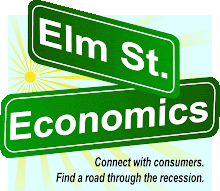Like most people, I’ve been hit with relentless waves of information about the recession. So while listening to Liz Ann Sonders at a recent conference of the Association of National Advertisers in New York, I was pretty excited to hear the chief investment strategist from Charles Schwab suggest that we may have hit bottom in the last two weeks of April or the first week in May… and that a recovery may be underway. Then, Ms. Sonders proceeded to go through a checklist of reasons for her suspicion.
She reminded the audience that new layoffs are a better indicator of economic health than real employment numbers… and the number of new layoffs has been dropping of late. She cited the sustained fall of long-term interest rates, the increase in consumer confidence, the low levels of wholesale inventories, and the imminent increase in new factory orders that should follow. And referring to these two elements as the most important indicators of improved economic health, she noted that the sale of homes and stocks are beginning to stabilize. (With the stock market, we’re not seeing the extreme spikes and drops that we saw over the winter. Overall, stock values are showing the power to sustain their gains, relatively speaking.)
But note the nuance, in her opening remarks: She said, “A” recovery may be underway. Not necessarily “The” recovery. Instead of a “V” at the bottom of a chart, our exit from the Great Recession could look more like a W… or a series of W’s. And just as there is no singular cause for a recession, there will be a number of drivers influencing the ebb and flow of these recoveries. But we can all agree that these issues are less scary if you see them coming.
The leading risk: Inflation. Wholesale inventories are low right now, and so are commodity prices. As consumers begin spending, and demand for new products rises, the supply of commodities may not keep up with demand, and a bidding war (inflation) could follow. [Note: An article about this risk, with regard to Oil, appeared here back on April 1st (The Fuel Economy), and in another story on April 28.] Unlike previous recessions, when companies had warehouses full of goods to satisfy their “just in case” strategy… technology has allowed companies to empty their warehouses and operate under a “just in time” strategy. So there’s not a huge backlog of goods to supply any sudden demand.
Another governor that could slow the engine of recovery: The de-leveraging of the consumer. Savings rates have shot up, use of credit has fallen. Retail sales that are credit-reliant (furniture, automotive, other big-ticket items) could see additional challenges on the road to recovery.
Implications: If your company is determined to “get aggressive” as soon as there are some signs that a recovery is underway, beware of two important caveats.
First, the recession and the recoveries may not be as distinct as black & white.
Second, don’t be discouraged if the impending “Ups” are seasoned with a few “Downs.”
Once again, all of this makes a strong case for the Elm Street Economics mentality… that you should focus less on what’s going on with Wall Street, Washington, or Ottawa (the macro economy), and focus more on the way you run your business, and the relationship you enjoy with the consumers who live down on Elm Street (which represent your company’s micro economy).
Let the recoveries begin.
Mike Anderson



No comments:
Post a Comment